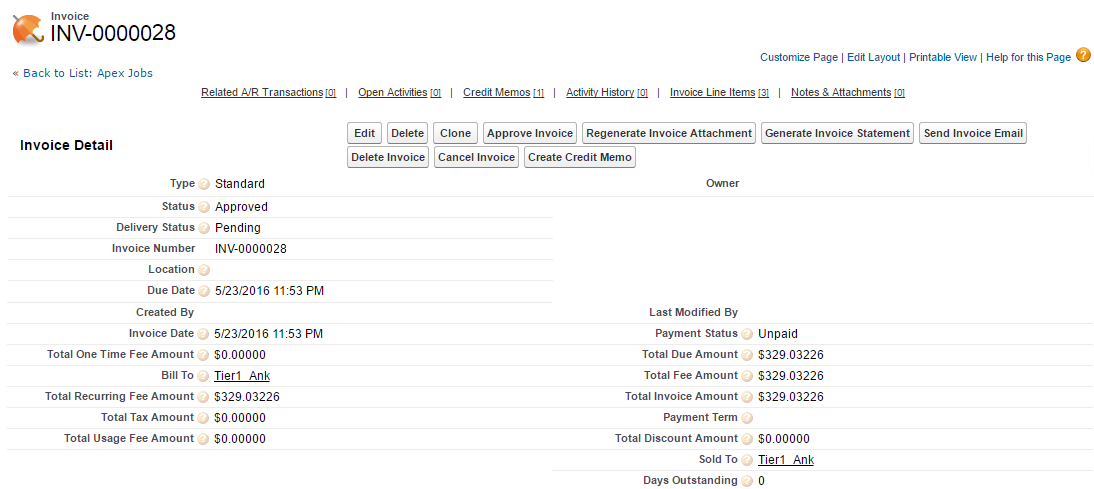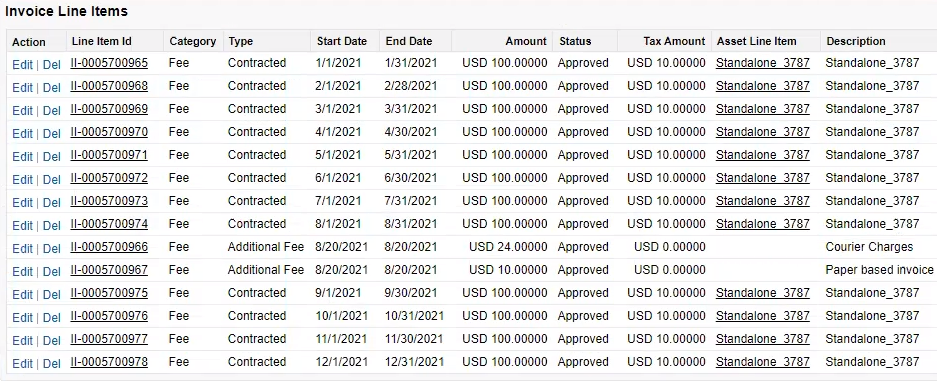Download PDF
Download page Invoice Detail.
Invoice Detail
You can see the invoices generated for an Account under the Invoices related list on the Accounts page.

Click the Invoice Number link to open an invoice.

Let us understand what each of the fields on Invoice Details means,
| Field | Description |
|---|---|
| Type | The default Invoice Type which is Standard. |
Status | The stage at which the invoice is in the entire process. An invoice can move to three statuses: Draft, Approved or Cancelled. For more information, please refer Invoice Life Cycle. |
Delivery Status | The status of invoice email delivery. The status is 'Pending' if the invoice is not delivered. If the invoice email is sent successfully, the status changes to 'Delivered'. |
| Invoice Number | A unique number which serves as identification for the invoice. For invoice numbering, you can either use a standard Salesforce field or add a custom field by modifying the page layout. For details on custom numbering, see Custom Numbering Callback Class. |
Due Date | The date by when this invoice should be paid by the customer. |
| Total Invoice Amount | The sum of all charges and applicable taxes associated with this invoice. Please note that due to the precision configuration, the Total Tax Amount might differ from the sum of Tax Amount on the Invoice Line Items. |
| Total Tax Amount | The Tax amount derived from aggregating the tax amount on each invoice line item. |
Days Outstanding | The number of days taken to collect the revenue from the invoice due date. |
| Total Additional Fee Amount | The sum of all additional invoice line items' amount (if any) in this invoice. If finance operations administrator has configured invoice fee types for the account, Conga Billing generates additional invoice line items for each invoice fee type associated with the account, during invoice generation. |
| Error Status | If you manually or automatically approve an invoice, any error during custom numbering or tax callback will be shown here. The status can be either "Custom Numbering Error" or "Tax Calculation Error". |
| Error Message | The details of exactly what went wrong during custom numbering or tax callback execution. |
Invoice objects contain Bill To Address, Ship To Address, and Sold To Address details.
- Bill To Address: The Billing Address of the Bill To account is used as the Bill To address of the invoice.
- Ship To Address:
Scenario: All invoice line items have the same Ship To Account.
If all invoice line items have the same Ship To Account, use that account as the Ship To Account of the invoice.Refer to the following table to determine which address is used as the Shipping Address of the Invoice.
Account Type of Address Address Present? Outcome Ship To Account Shipping Address Is Present Used as the Shipping Address of the Invoice Not Present Checks for Billing Address Billing Address Is Present Used as the Shipping Address of the Invoice Not Present Shipping Address of the Invoice is left blank Scenario: All invoice line items do not have Ship To Account.
If all invoice line items do not have Ship To Account, the Ship To Account of the invoice is left blank.Refer to the following table to determine which address is used as the Shipping Address of the Invoice.
Account Type of Address Address Present? Outcome Bill To Account Shipping Address Is Present Used as the Shipping Address of the Invoice Not Present Checks for Billing Address Billing Address Is Present Used as the Shipping Address of the Invoice Not Present Shipping Address of the Invoice is left blank Scenario: All invoice line items have different Ship To Accounts.
If all invoice line items do not have different Ship To Account, the Ship To Account along with the Shipping Address is left blank.
- Sold To Address: If all the invoice line items have the same Sold To account, the Sold To account of all the invoice line items is used as the Sold To account of the invoice.
The Billing Address of the Sold To account is used. If there is no Billing Address associated with the Sold To account, the Sold To account and the Sold to Address is left blank.
It is left blank if all the invoice line items have different Sold To accounts or there are no Sold To accounts associated with all the invoice line items.
An Address is not considered valid if the Street field is missing in the address.
You can perform following actions on an invoice:
- Approve Invoice: The initial status of an invoice is Draft. The moment you click Approve Invoice, the invoice moves to Approved state. Similarly, you can Cancel or Delete an invoice. Please see Invoice Lifecycle for details.
- Regenerate Invoice Attachment: To regenerate Invoice document, click Regenerate Invoice Attachment. The invoice document will be available as an attachment under Notes & Attachment related list.
If Custom Invoice Numbering is activated, the Invoice document name will have the format - 'Custom Invoice Number'_'Template Name'_Date. If not, the document name will consist of the Salesforce Auto Number.
- Send Invoice Email: To email this invoice, click Send Invoice. The Delivery Status will change from Pending to Delivered after the invoice is emailed to the contact. Please see Sending an Invoice Email.
- Generate Invoice Statement: To generate an invoice statement that lists all purchases till the specified date, click Generate Invoice Statement. Please see Generating an Invoice Statement.
- Create Credit Memo: To generate a Credit Memo manually from the invoice, click Create Credit Memo. Please see Generating Credit Memos from Invoice.
If your invoice contains a large number of invoice line items, a batch job is submitted in the background to process them.
You can also check the Activity History related list on this page to track the email activities for this Invoice. Check out Billing System Properties to turn off the activity tracking.
Invoice Line Items
You can also see the Invoice Line Items related list under Invoice. Each Invoice Line Item represents the purchased product and its price. Invoice Line Items together form an Invoice. There is a one-to-one mapping between billing schedules and invoice line items. For example, if the Invoice Run job fetches the billing schedules:
- BS-00000048
- BS-00000051
And creates following invoice line items:
- II-0000000080
- II-0000000081
The invoice line item II-0000000080 is mapped to BS-00000048.
If finance operations administrator has configured invoice fee types for the account, Conga Billing generates additional invoice line items for each invoice fee type associated with the account, during invoice generation. For example, if there are three invoice fee types associated with the account, Conga Billing creates three invoice line items during invoice generation.
You can create a manual credit memo for the additional invoice line items. You can split the invoice that has additional invoice line items. You can perform all actions (such as Approve, Cancel) that are available after the invoice generation, on the additional invoice line items also.

Click Invoice Line Item Id to open the Invoice Line Item Detail page.

Let us understand what each of the fields on Invoice Line Item Detail means,
| Field | Description |
|---|---|
| Taxable | Indicates if the purchase represented by the line item is taxable. |
Tax Amount | The amount of tax on the purchase associated with an individual invoice line item. This amount is aggregated to show the Total Tax Amount on the Invoice. |
Location | The location of the associated Account. |
Tax Inclusive | Indicates if the fee includes a tax amount. |
| Line Item Id | A unique number for each Invoice Line Item identification. |
Invoice | ID which this invoice line item is a part of. |
Invoice Line Item contains Bill To Address, Ship To Address, and Sold To Address details.
- Bill To Address: The Billing Address of the parent invoice is used as the Bill To Address for the invoice line item.
- Ship To Address: Refer to the following table to determine which address is used as the Shipping Address of the Invoice Line Item.
Account Type of Address Address Present? Outcome Ship To Account Shipping Address Is Present Used as the Shipping Address of the Invoice Line Item Not Present Checks for Billing Address Billing Address Is Present Used as the Shipping Address of the Invoice Line Item Not Present Shipping Address of the Invoice Line Item is left blank Sold To Address: The Sold To account mentioned in the Invoice is used as the Sold To account of the Invoice Line Item. The Billing Address of the Sold To account is used as the Sold To address for the invoice line item. It is left blank if there is no Billing Address with the Sold To account or there is no account mentioned in the Sold To field.
An Address is not considered valid if the Street field is missing in the address.